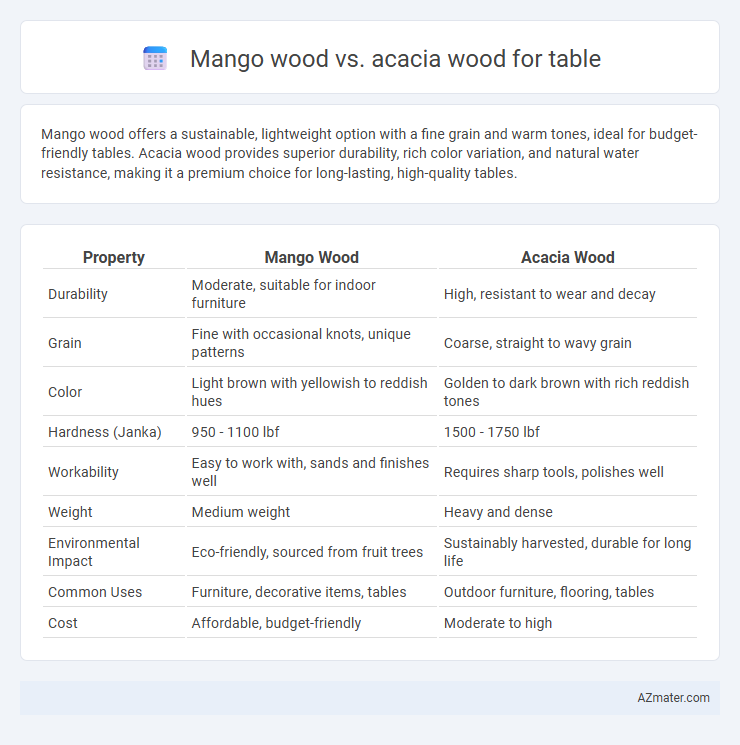Mango wood offers a sustainable, lightweight option with a fine grain and warm tones, ideal for budget-friendly tables. Acacia wood provides superior durability, rich color variation, and natural water resistance, making it a premium choice for long-lasting, high-quality tables.
Table of Comparison
| Property | Mango Wood | Acacia Wood |
|---|---|---|
| Durability | Moderate, suitable for indoor furniture | High, resistant to wear and decay |
| Grain | Fine with occasional knots, unique patterns | Coarse, straight to wavy grain |
| Color | Light brown with yellowish to reddish hues | Golden to dark brown with rich reddish tones |
| Hardness (Janka) | 950 - 1100 lbf | 1500 - 1750 lbf |
| Workability | Easy to work with, sands and finishes well | Requires sharp tools, polishes well |
| Weight | Medium weight | Heavy and dense |
| Environmental Impact | Eco-friendly, sourced from fruit trees | Sustainably harvested, durable for long life |
| Common Uses | Furniture, decorative items, tables | Outdoor furniture, flooring, tables |
| Cost | Affordable, budget-friendly | Moderate to high |
Introduction to Mango Wood and Acacia Wood
Mango wood, derived from the fast-growing mango tree, is prized for its sustainability, rich grain patterns, and durability, making it an eco-friendly choice for table construction. Acacia wood, sourced from the hardwood Acacia tree, is renowned for its density, natural resistance to water and wear, and distinctive deep hues, ideal for robust and long-lasting furniture. Both woods offer unique aesthetic and functional benefits, with mango wood favored for its affordability and environmental impact, while acacia wood excels in strength and moisture resistance.
Origin and Sustainability
Mango wood originates from the mango tree (Mangifera indica), primarily grown in South Asia, making it a sustainable choice due to the tree's dual role in fruit production and timber harvesting after fruiting ends. Acacia wood, derived from Acacia trees native to Australia, Africa, and parts of Asia, is valued for its rapid growth and ability to thrive in arid environments, leading to sustainable forestry practices. Both mango and acacia woods promote eco-friendly furniture production by utilizing fast-growing species that reduce deforestation pressures on slower-growing hardwoods.
Appearance and Color Variations
Mango wood features a warm, golden-brown tone with distinctive grain patterns that range from yellowish to darker streaks, making each table uniquely attractive. Acacia wood offers rich reddish-brown hues with natural dark veins and a smooth, glossy finish that enhances its elegant appearance. Both woods showcase striking color variations, but Mango wood tends to present more rustic and varied tones, while Acacia provides a consistent, polished look ideal for stylish furniture.
Durability and Hardness
Mango wood offers moderate durability and hardness, making it suitable for indoor tables with light to medium use, while Acacia wood is renowned for its high density and superior hardness, providing exceptional resistance to wear and impact. Acacia's natural oils enhance its durability, making it more resistant to moisture and decay compared to mango wood. For tables requiring long-lasting strength and robustness, Acacia wood is generally the preferred choice due to its greater hardness rating on the Janka scale.
Maintenance and Care Requirements
Mango wood tables require regular oiling or waxing to maintain their natural luster and prevent drying or cracking, making maintenance moderately demanding. Acacia wood is highly durable and naturally resistant to scratches and moisture, needing only occasional cleaning with a damp cloth and mild soap to preserve its appearance. Both woods benefit from avoiding prolonged exposure to direct sunlight and extreme humidity for optimal longevity.
Cost Comparison
Mango wood tables generally cost less than acacia wood due to the faster growth rate and greater abundance of mango trees, making it a budget-friendly option for durable furniture. Acacia wood, known for its hardness and rich grain, is typically priced higher because it takes longer to mature and requires more processing. When considering long-term investment, acacia wood offers better resistance to wear and tear, while mango wood provides an affordable, sustainable alternative without sacrificing aesthetic appeal.
Eco-Friendliness and Environmental Impact
Mango wood is highly regarded for its sustainability due to its use of harvested fruit trees that no longer produce fruit, reducing deforestation and waste. Acacia wood, while durable and visually appealing, often comes from slow-growing trees that can lead to higher environmental impact if not sourced responsibly. Choosing mango wood tables supports eco-friendly practices by promoting the reuse of agricultural byproducts and minimizing the demand for virgin hardwood forests.
Suitability for Table Designs
Mango wood offers a smooth, fine grain ideal for intricate table designs that require detailed carving and a polished finish, making it suitable for both traditional and contemporary styles. Acacia wood is denser and more durable, with a rich, varied grain pattern that enhances rustic and handcrafted table designs, providing excellent resistance to wear and moisture. Both woods excel in table construction, but mango wood suits lighter, decorative pieces while acacia wood is preferred for robust, long-lasting furniture.
Pros and Cons of Mango Wood Tables
Mango wood tables are praised for their sustainability, affordability, and distinctive grain patterns that add warmth and character to any space. The wood is relatively soft, making it easier to work with but more susceptible to dents and scratches compared to harder woods like acacia. Despite its lower durability, mango wood resists water and fungal attacks well, making it suitable for indoor furniture requiring moderate wear resistance.
Pros and Cons of Acacia Wood Tables
Acacia wood tables are highly durable and resistant to moisture, making them ideal for both indoor and outdoor use. The rich, warm tones and distinctive grain patterns enhance aesthetic appeal, but Acacia wood can be prone to scratching and requires regular maintenance to preserve its finish. While generally heavier and more expensive than other hardwoods like Mango, Acacia offers superior strength and longevity.

Infographic: Mango wood vs Acacia wood for Table
 azmater.com
azmater.com